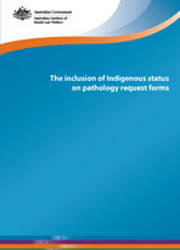Summary
Most pathology request forms do not include an Indigenous status identifier. This means that Indigenous data cannot flow from medical practitioners to pathology laboratories and from pathology laboratories to state and territory health registries. The inclusion of Indigenous status on pathology forms depends on information from the 'source' of pathology service requests-medical practitioners, surgeons or administrative staff who complete patient records. As pathology providers rely on the request form, the quality of Indigenous status information collected and recorded at source is imperative to improving identification in health registries.
Under the National Indigenous Reform Agreement (NIRA) in 2008, the Council of Australian Governments (COAG) agreed to various data quality improvements. Many of these, detailed in Schedule F of the NIRA, are focused on improving Indigenous identification in key health data sets (COAG 2011). This document was prepared by the AIHW with the input of state and territory cancer, communicable disease and cervical screening registries; Medicare Australia, the Department of Health and Ageing, the National Coalition of Public Pathology, the Public Health Laboratory Network, National Advisory Group Aboriginal and Torres Strait Islander Health Information and Data, the National Health Information Statistics and Standards Committee, and the National Indigenous Reform Agreement Performance Information Management Group.
Work on the business case began in November 2009. A consultation draft was completed in March 2010 and the Australian Institute of Health and Welfare consulted state and territory disease registries (within health departments) between April and May 2010. National committees were consulted extensively between June 2010 and August 2011. This report reflects the work undertaken during that period.
The business case shows that to improve Indigenous identification in the national health registries for cancer, communicable disease and cervical screening, the inclusion of Indigenous status on pathology request forms is key.
Some jurisdictions have already introduced Indigenous status on their pathology request forms. In addition, while the business case was being developed, progress has been made in e-health records development and uptake. The recommendations build on these two key developments.
Recommendation 1: There should be a focus on improving Indigenous identification in national health registries as part of broader work using electronic health records, and it should be part of any development of a National Minimum Data Set on primary health care.
Recommendation 2: Jurisdictions should progress the inclusion of Indigenous status on pathology request forms through mechanisms identified below:
- Continuation of projects/pilot studies to include Indigenous status on pathology forms and consideration of their roll out state-wide.
- Changes to state and territory public health legislation and regulations.
- Changes for disease registries to adhere to the national standard format for Indigenous status.
- Coordination between jurisdictions to achieve standardised requirements for pathology providers (and others affected by the proposed changes).
Preliminary material: Acknowledgments; Abbreviations; Symbols
1 Introduction
2 Previous and current studies
2.1 Previous studies
2.2 Current studies
3 The situation in 2011
3.1 National standards
3.2 Pathology request forms
3.3 Overview of data flow
3.4 Communicable disease registries
3.5 Cancer registries
3.6 Cervical screening registries
3.7 Other health registries
3.8 Pathology providers and laboratories
3.9 Software vendors
4 Recommendations of the 2011 business case
5 Work following the development of the business case
Appendixes
Appendix A Changes identified by the 2011 business case
Appendix B Cost benefit analysis
Appendix C Options to improve Indigenous identification
Appendix D Other sources of Indigenous status information
Appendix E Communicable disease registries
Appendix F Cancer registries
Appendix G Cervical screening registries
Appendix H Example pathology request form which includes an Indigenous identifier
End matter: References; List of tables; List of figures



